A Novel Integrated Profit Maximization Model for Retailers under Varied Penetration Levels of Photovoltaic Systems
Abstract
:1. Introduction
- (i)
- All the studies concerned with the Retailer profit maximization problem do not involve wholesale market clearing problems. The wholesale operation is not examined, and thus potential changes in the electricity generation mix are not validated in terms of retail market conditions. More specifically, there is little evidence in the literature on how increased capacity of renewably energy influences the cost of electricity and the RTP offered to the consumers that reflect this cost.
- (ii)
- The pool market prices are simulated as stochastic variables through a scenarios based approach. By incorporating stochastic programming simulations in mixed-integer linear problems, the overall complexity of the optimization problem increases.
- (iii)
- The topic of dynamic pricing has not received considerable attention. In the majority of the studies the selling price is fixed and not time-variant.
2. Methodology
2.1. General Framework
2.2. Mathematical Formulation of the Wholesale Market Optimization Model
- price ()—quantity () pair for the energy supply of type- power units,
- price ()—quantity () pair for the energy supply of electricity imports ,
- price ()—quantity () pair for the energy consumption of electricity exports , and
- price ()—quantity () pair for the energy consumption of electricity demand bids .
- primary-up reserve requirements (),
- primary-down reserve requirements (),
- secondary-up reserve requirements (),
- secondary-down reserve requirements (), and
- tertiary reserve requirements ().
2.2.1. Objective Function of the Wholesale Market Optimization Problem
2.2.2. Energy Demand Balance
2.2.3. Operational Constraints
2.2.4. Reserve Provision Limits
2.2.5. System’s Reserve Requirements
2.2.6. Renewable Energy Generation
2.2.7. Hydroelectric Power Generation
2.2.8. Time-Related Constraints
2.2.9. Net Electricity Trading
2.3. Mathematical Formulation of the Retail Market Optimization Model
2.3.1. Future Market
- Period#1={01:00,02:00,03:00,04:00,05:00,06:00,07:00,08:00,09:00,10:00,11:00,12:00,13:00,14:00}
- Period#2={15:00,16:00,17:00,18:00}
- Period#3={19:00, 20:00,21:00, 22:00}
- Period#4={23:00,24:00}
2.3.2. Pool Market
2.3.3. Demand Response
2.3.4. Demand Balance
2.3.5. Selling Price Limit
2.3.6. Expected Profit and Network Access Costs
2.3.7. Objective Function of the Retail Market Optimization Problem
3. Results
4. Conclusions
- The methodology of the paper unifies the wholesale and retail market operations through two optimization models. The first one refers to a market-learning price problem where the objective is to minimize electricity generation cost. The decision variables of the problem are the schedules of the power plants and interconnection exchanges. The retail market model aims at the maximization of the Retailer’s profit. Here the decision variables are the procurement mechanism and the real-time selling prices to the consumers.
- The unified consideration of the two markets minimizes the Retailer’s economic risks and allows more robust and reliable strategic decisions of the Retailer in the competitive retail market. Wholesale market prices are not modeled as stochastic variables but are a product of the solution of the wholesale market operation.
- Both models are flexible in terms of further expansions and additions. In particular, the retail market model can take into consideration different price/demand function, elasticity values, and electricity tariff structures.
- The methodology of the paper quantifies and evaluates how different PV penetration levels affect the selling prices to the consumers. RTPs are implemented in the model in order to connect wholesale market conditions to the retail market. The actual electricity costs are transferred to the consumers. By modeling the consumer’s response to the selling prices, load management techniques can be manifested, leading to benefits on the retail side, e.g., lower electricity costs for consumers, and on the wholesale side, e.g., congestion management in the transmission and distribution levels and others.
Author Contributions
Funding
Institutional Review Board Statement
Informed Consent Statement
Conflicts of Interest
Nomenclature
| Sets | |
| Set of thermal and nuclear power units | |
| Set of hydroelectric units | |
| Set of hydroelectric and renewable energy units | |
| Set of hydrothermal units | |
| Set of blocks of energy supply and consumption functions | |
| Set of demand entities | |
| Set of interconnection for energy imports | |
| Set of nuclear units | |
| Set of renewable energy sources | |
| Set of time periods | |
| Set of thermal units | |
| Set of interconnection for energy exports | |
| Parameters | |
| Cost of each block of each type- unit’s energy supply function in period [€/MW] | |
| Availability factor of unit in period [pu] | |
| Cost of each unit’s energy supply offer in period t [€/MW] | |
| Available quantity of block of each demand entity’s energy consumption function in period [MW] | |
| Available quantity of block of each type- unit’s energy supply function in period [MW] | |
| Available quantity of block of each interconnection’s energy supply function in period [MW] | |
| Available quantity of block of each interconnection’s energy consumption function in period [MW] | |
| Cost of each block of each demand entity’s energy consumption function in period [€/MW] | |
| Primary-down reserve supply cost of type-l unit in period t [€/MW] | |
| Primary-up reserve supply cost of type-l unit in period t [€/MW] | |
| Secondary -down reserve supply cost of type-l unit in period t [€/MW] | |
| Secondary-up reserve supply cost of type-l unit in period t [€/MW] | |
| Tertiary reserve supply cost of type-l unit in period t [€/MW] | |
| Shut-down cost of type- unit [€/shut-down] | |
| Start-up cost of type- unit [€/start-up] | |
| Cost of each block of each interconnection’s energy supply function in period [€/MW] | |
| Unmet energy cost in period [€/MW] | |
| Unmet reserves cost in period t [€/MW] | |
| Cost of each block of each interconnection’s energy consumption function in period [€/MW] | |
| Primary-down reserve requirements in period [MW] | |
| Primary-up reserve requirements in period [MW] | |
| Secondary-down reserve requirements in period [MW] | |
| Secondary-up reserve requirements in period [MW] | |
| Tertiary reserve requirements in period [MW] | |
| Maximum daily amount of hydroelectric generation in date [MWh] | |
| Available maximum capacity of unit in period [MW] | |
| Technical maximum of type- unit under automatic generation control [MW] | |
| Technical maximum of type- unit [MW] | |
| Technical minimum of type- unit under automatic generation control [MW] | |
| Technical minimum of type- unit [MW] | |
| Installed capacity of unit [MW] | |
| Ramp-down limit of type- unit in period [MW/min] | |
| Ramp-down limit of type- unit under automatic generation control in period [MW/min] | |
| Ramp-up limit of type- unit in period [MW/min] | |
| Ramp-up limit of type- unit under automatic generation control in period [MW/min] | |
| Maximum primary-down reserve supply of type- unit [MW] | |
| Maximum primary-up reserve supply of type- unit [MW] | |
| Maximum tertiary non-spinning reserve supply of type- unit [MW] | |
| Maximum tertiary spinning reserve supply of type- unit [MW] | |
| Minimum downtime of type- unit [h] | |
| Minimum uptime of type- unit [h] | |
| Continuous variables | |
| Cleared quantity of block of each type- unit’s energy supply function in period (MW) | |
| Cleared quantity of block of each demand entity’s energy consumption function in period (MW) | |
| Cleared quantity of block of each interconnection’s energy supply function in period (MW) | |
| Cleared quantity of block of each interconnection’s energy consumption function in period (MW) | |
| Cleared quantity of unmet energy demand in period [MW] | |
| Cleared quantity of the curtailed energy of unit in time period [MW] | |
| Cleared quantity of unmet primary-down reserve requirements in period [MW] | |
| Cleared quantity of unmet primary-up reserve requirements in period [MW] | |
| Cleared quantity of unmet secondary-down reserve requirements in period [MW] | |
| Cleared quantity of unmet secondary-up reserve requirements in period [MW] | |
| Cleared quantity of unmet tertiary reserve requirements in period [MW] | |
| Cleared power output of unit in time period [MW] | |
| Cleared power output of unit in time period [MW] | |
| Cleared power consumption of demand entity in time period [MW] | |
| Cleared power output of interconnection in time period [MW] | |
| Cleared power output of unit in time period [MW] | |
| Cleared power output of unit in time period [MW] | |
| Cleared power output of unit in time period [MW] | |
| Cleared power consumption of interconnection in time period [MW] | |
| Cleared primary-down reserve provision of type- unit in period t [MW] | |
| Cleared primary-up reserve provision of type- unit in period t [MW] | |
| Cleared secondary-down reserve provision of type- unit in period t [MW] | |
| Cleared secondary-up reserve provision of type- unit in period t [MW] | |
| Cleared tertiary reserve provision of type- unit in period t [MW] | |
| Cleared tertiary non-spinning reserve provision of type- unit in period t [MW] | |
| Cleared tertiary spinning reserve provision of type- unit in period t [MW] | |
| Binary variables | |
| 1, if type- unit operates in dispatch phase in period 0, otherwise | |
| 1, if type- unit provides non-spinning tertiary reserve in period 0, otherwise | |
| 1, if type- unit operates under automatic generation control in period 0, otherwise | |
| 1, if type- unit starts-up in period 0, otherwise | |
| 1, if type- unit shuts-down in period 0, otherwise | |
References
- Siksnelyte, I.; Zavadskas, E.M. Achievements of the European Union countries in seeking a sustainable electricity sector. Energies 2019, 12, 2254. [Google Scholar] [CrossRef] [Green Version]
- Hyland, M. Restructuring European electricity markets—A panel data analysis. Util. Pol. 2016, 30, 33–42. [Google Scholar] [CrossRef] [Green Version]
- Newbery, D.; Strbac, G.; Viehoff, I. The benefits of integrating European electricity markets. Energy Pol. 2016, 94, 253–263. [Google Scholar] [CrossRef] [Green Version]
- Ringler, P.; Keles, D.; Fichtner, W. How to benefit from a common European electricity market design. Energy Pol. 2017, 101, 629–643. [Google Scholar] [CrossRef]
- Sencar, M.; Pozeb, V.; Krope, T. Development of EU (European Union) energy market agenda and security of supply. Energy 2014, 77, 117–124. [Google Scholar] [CrossRef]
- Correljé, A.F.; De Vries, L.J. Competitive Electricity Markets Design, Implementation, Performance. Elsevier Global Energy Policy and Economics Series, 1st ed.; Elsevier Science: Amsterdam, The Netherlands, 2008. [Google Scholar]
- Sioshansi, F.; Pfaffenberger, W. Electricity Market Reform: An International Perspective, 1st ed.; Elsevier Science: Amsterdam, The Netherlands, 2006. [Google Scholar]
- Bae, M.; Kim, H.; Kim, E.; Chung, A.Y.; Kim, H.; Roh, J.H. Toward electricity retail competition: Survey and case study on technical infrastructure for advanced electricity market system. Appl. Energy 2014, 133, 252–273. [Google Scholar] [CrossRef]
- Boroumand, R.H.; Goutte, S.; Porcher, S.; Porcher, T. Hedging strategies in energy markets: The case of electricity retailers. Energy Econ. 2015, 51, 503–509. [Google Scholar] [CrossRef]
- Guo, Y.; Shao, P.; Wang, J.; Dou, X.; Zhao, W. Purchase strategies for power retailers considering load deviation and CVaR. Energy Proc. 2019, 158, 6658–6663. [Google Scholar] [CrossRef]
- Gabriel, S.A.; Genc, M.F.; Balakrishnan, S. A simulation approach to balancing annual risk and reward in retail electrical power markets. IEEE Trans. Power Syst. 2002, 17, 1050–1057. [Google Scholar] [CrossRef]
- Gabriel, S.A.; Conejo, A.J.; Plazas, M.A.; Balakrishnan, S. Optimal price and quantity determination for retail electric power contracts. IEEE Trans. Power Syst. 2006, 21, 180–187. [Google Scholar] [CrossRef]
- Carrión, M.; Conejo, A.J.; Arroyo, J.M. Forward contracting and selling price determination for a retailer. IEEE Trans. Power Syst. 2007, 22, 2105–2114. [Google Scholar] [CrossRef]
- Yusta, J.M.; Rosado, I.J.R.; Navarro, J.A.D.; Vidal, J.M.P. Optimal electricity price calculation model for retailers in a deregulated market. Int. J. Electr. Power Energy Syst. 2005, 27, 437–447. [Google Scholar] [CrossRef]
- Carrión, M.; Arroyo, J.M.; Conejo, A.J. A bilevel stochastic programming approach for retailer futures market trading. IEEE Trans. Power Syst. 2009, 24, 1446–1456. [Google Scholar] [CrossRef]
- Hatami, R.A.; Seifi, H.; Sheikh-El-Eslami, M.K. Optimal selling price and energy procurement strategies for a retailer in an electricity market. Electr. Power Syst. Res. 2009, 79, 246–254. [Google Scholar] [CrossRef]
- Sun, B.; Wang, F.; Xie, J.; Sun, X. Electricity Retailer trading portfolio optimization considering risk assessment in Chinese electricity market. Electr. Power Syst. Res. 2021, 190, 1–12. [Google Scholar] [CrossRef]
- Chawda, S.; Mathuria, P.; Bhakar, R. Risk-based retailer profit maximization: Time of use price setting for elastic demand. Int. Trans. Electr. Energ. Syst. 2019, 29, 1–22. [Google Scholar] [CrossRef]
- Sekizaki, S.; Nishizaki, I.; Hayashida, T. Decision making of electricity retailer with multiple channels of purchase based on fractile criterion with rational responses of consumers. Int. J. Electr. Power Energy Syst. 2019, 105, 877–893. [Google Scholar] [CrossRef]
- Charwand, M.; Gitizadeh, M.; Siano, P. A new active portfolio risk management for an electricity retailer based on a drawdown risk preference. Energy 2017, 118, 387–398. [Google Scholar] [CrossRef]
- Boroumanda, R.H.; Goutteb, S.; Guesmid, K.; Porchera, T. Potential benefits of optimal intra-day electricity hedging for the environment: The perspective of electricity retailers. Energy Pol. 2019, 132, 1120–1129. [Google Scholar] [CrossRef] [Green Version]
- do Prado, J.C.; Qiao, W. A stochastic decision-making model for an electricity retailer with intermittent renewable energy and short-term demand response. IEEE Trans. Smart Grid 2019, 10, 2581–2592. [Google Scholar] [CrossRef]
- Fateh, H.; Safari, A.; Bahramara, S. A bi-level optimization approach for optimal operation of distribution networks with retailers and micro-grids. J. Oper. Autom. Power Eng. 2020, 8, 15–21. [Google Scholar]
- Algarvio, H.; Lopes, F.; Sousa, J.; Lagarto, J. Multi-agent electricity markets: Retailer portfolio optimization using Markowitz theory. Electr. Power Syst. Res. 2017, 148, 282–294. [Google Scholar] [CrossRef]
- Nojavan, S.; Zare, K. Optimal energy pricing for consumers by electricity retailer. Int. J. Electr. Power Energy Syst. 2018, 102, 401–412. [Google Scholar] [CrossRef]
- Charwand, M.; Gitizadeh, M. Risk-based procurement strategy for electricity retailers: Different scenario-based methods. IEEE Trans. Eng. Manag. 2020, 67, 1–11. [Google Scholar] [CrossRef]
- Qadrdan, M.; Cheng, M.; Wu, J.; Jenkins, N. Benefits of demand-side response in combined gas and electricity networks. Appl. Energy 2017, 19215, 360–369. [Google Scholar] [CrossRef] [Green Version]
- Alipour, M.; Zare, K.; Seyedi, H.; Jalali, M. Real-time price-based demand response model for combined heat and power systems. Energy 2019, 1681, 1119–1127. [Google Scholar] [CrossRef]
- Yusta, J.M.; Khodr, H.M.; Urdaneta, A.J. Optimal pricing of default customers in electrical distribution systems: Effect behavior performance of demand response models. Electr. Power Syst. Res. 2007, 77, 548–558. [Google Scholar] [CrossRef]
- Mahmoudi-Kohan, N.; Parsa Moghaddam, M.; Sheikh-El-Eslami, M.K. An annual framework for clustering-based pricing for an electricity retailer. Electr. Power Syst. Res. 2010, 80, 1042–1048. [Google Scholar] [CrossRef]
- Mahmoudi-Kohan, N.; Parsa Moghaddam, M.; Sheikh-El-Eslami, M.K.; Shayesteh, E. A three-stage strategy for optimal price offering by a retailer based on clustering techniques. Int. J. Electr. Power Energy Syst. 2010, 32, 1135–1142. [Google Scholar] [CrossRef]
- Brooke, A.; Kendrick, D.; Meeraus, A.; Raman, R. GAMS: A User’s Guide; GAMS Development Corporation: Washington, DC, USA, 1998. [Google Scholar]
- Energy Exchange Group, S.A. Available online: http://www.enexgroup.gr/nc/en/home/ (accessed on 25 December 2020).

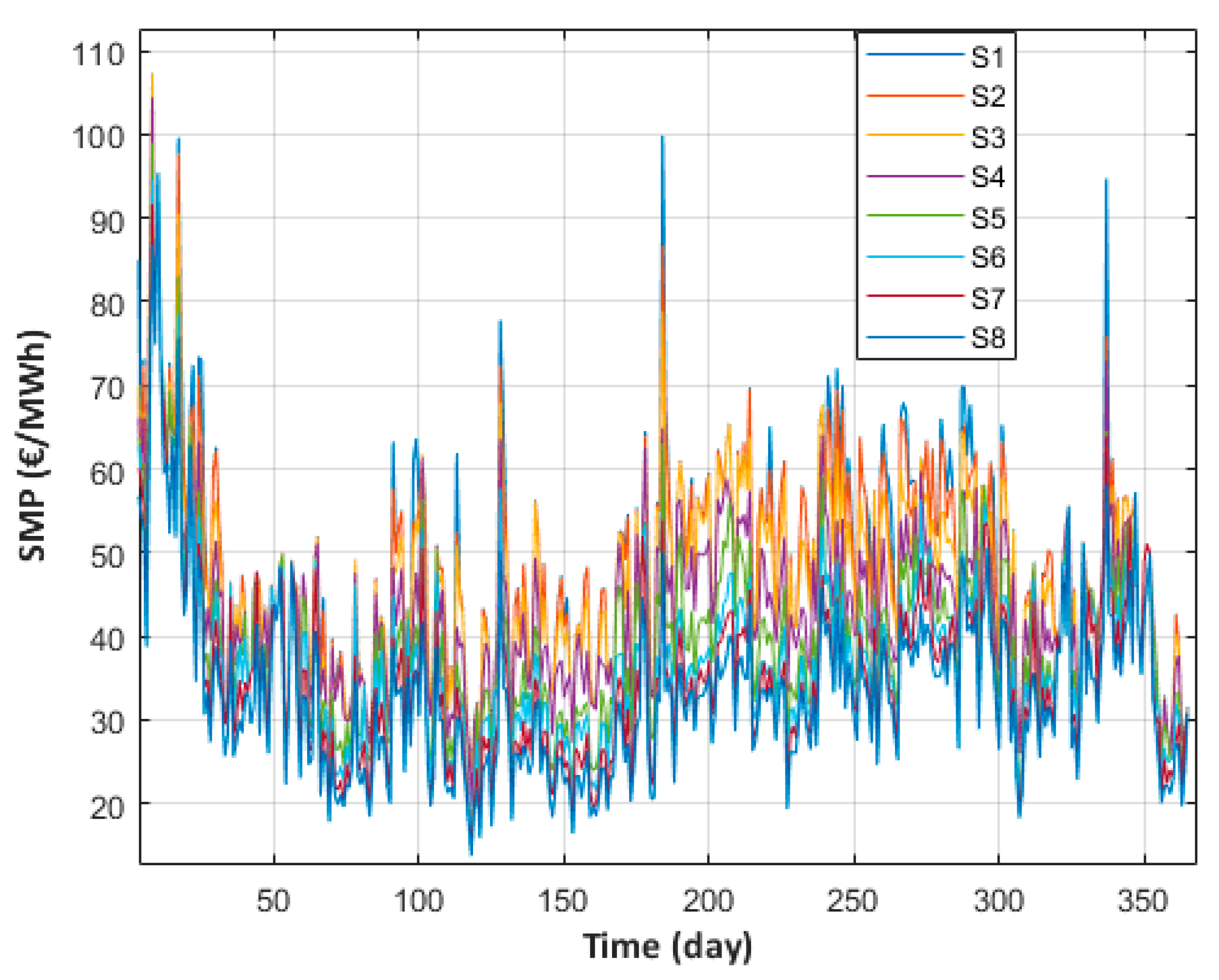

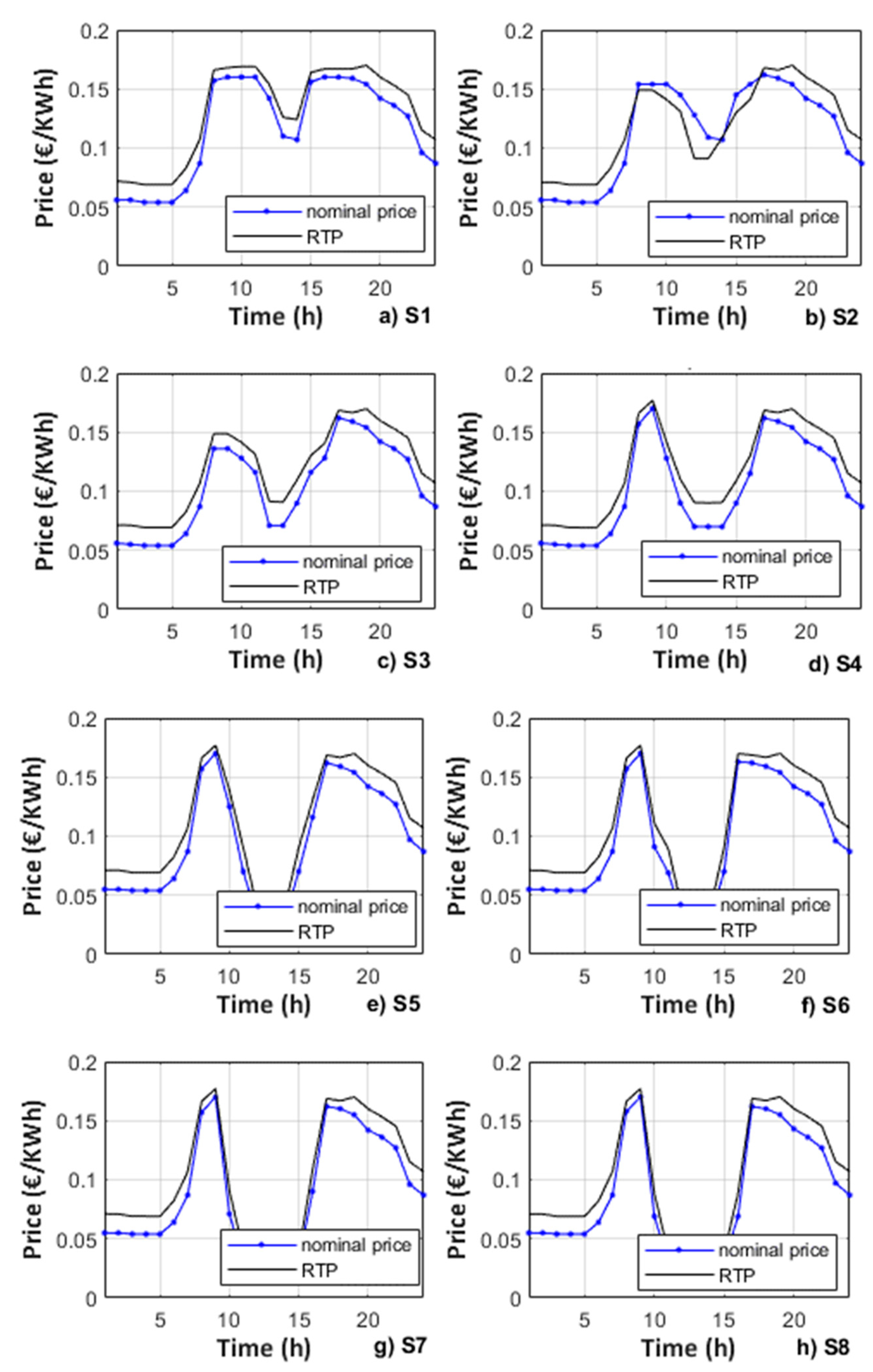
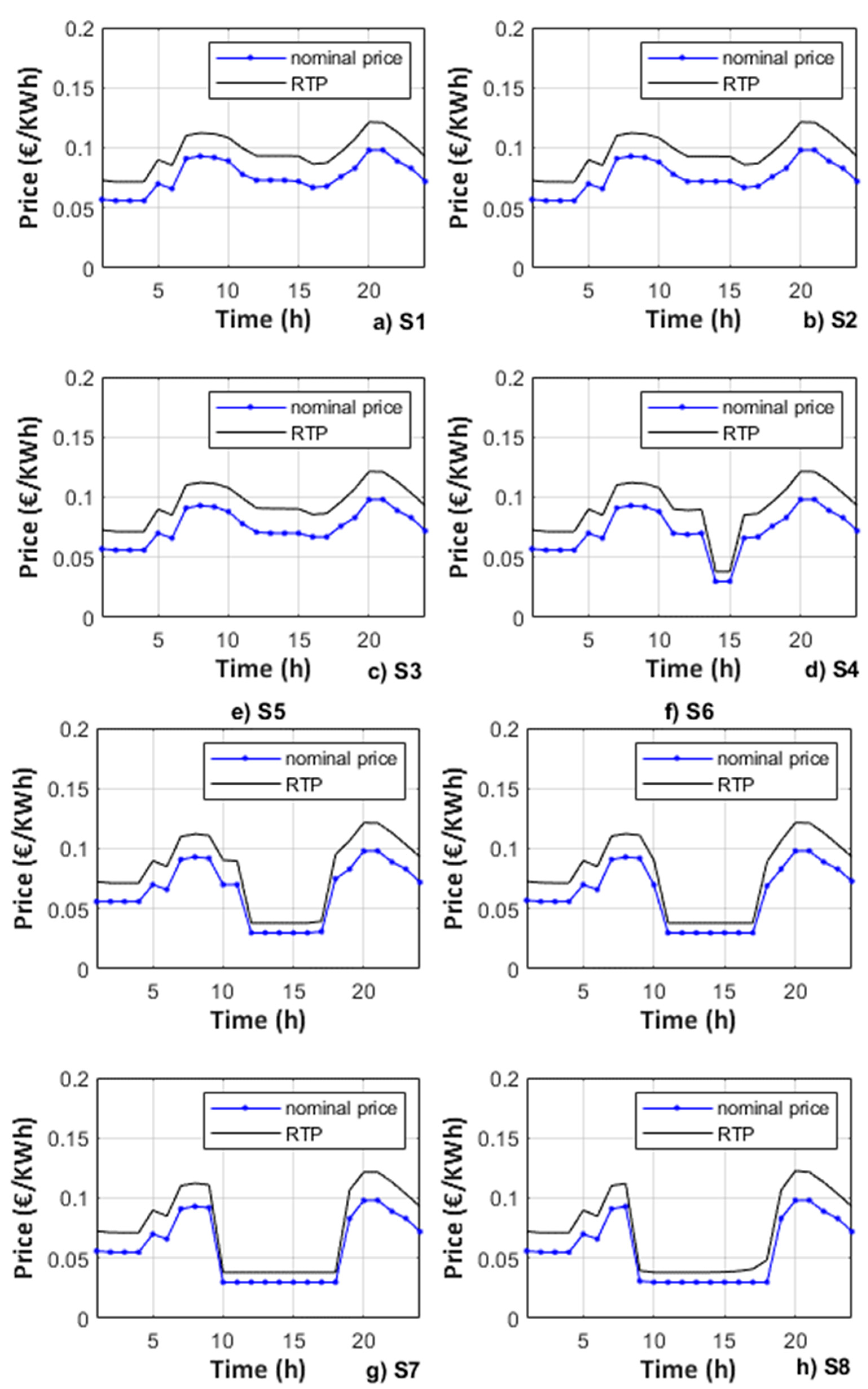


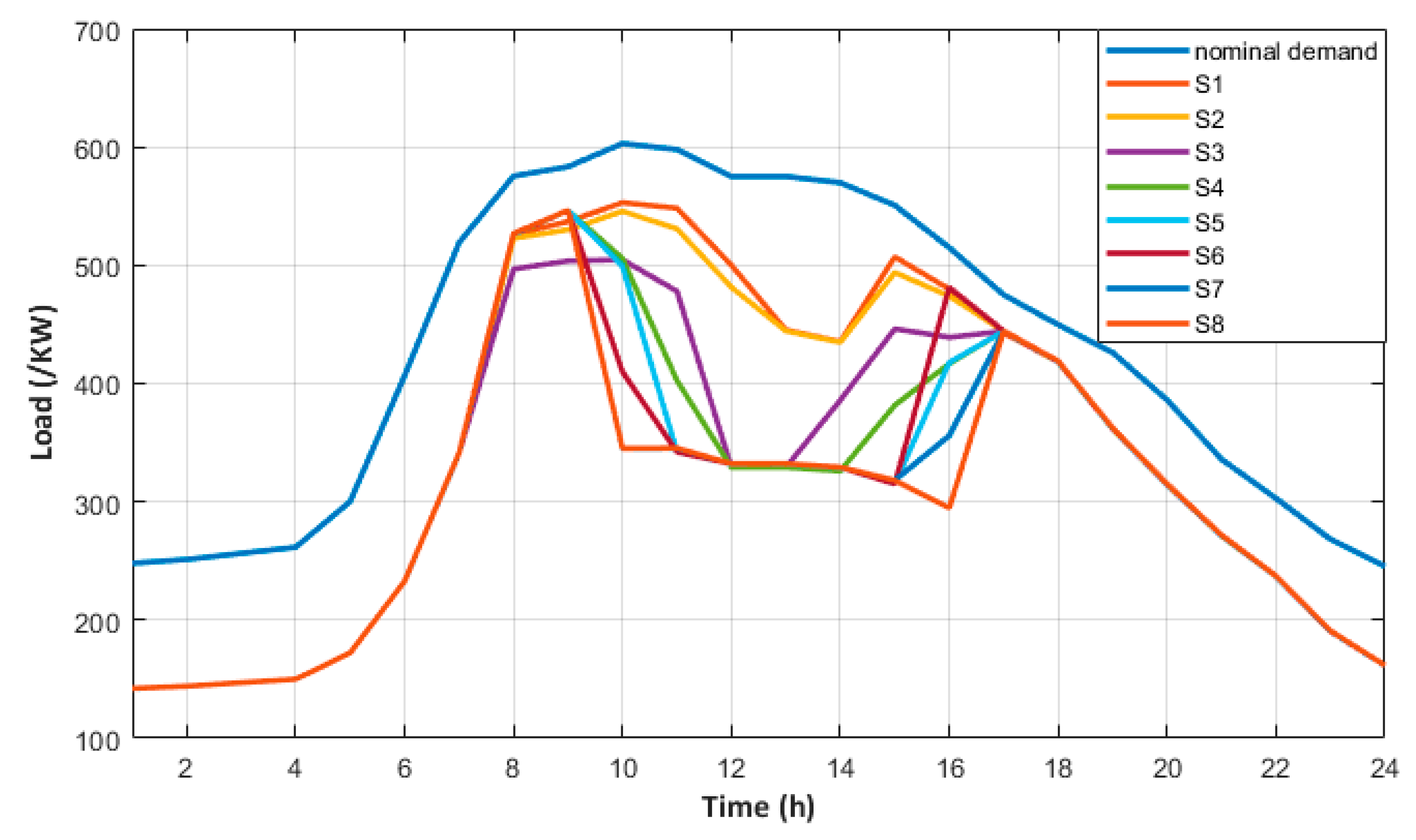
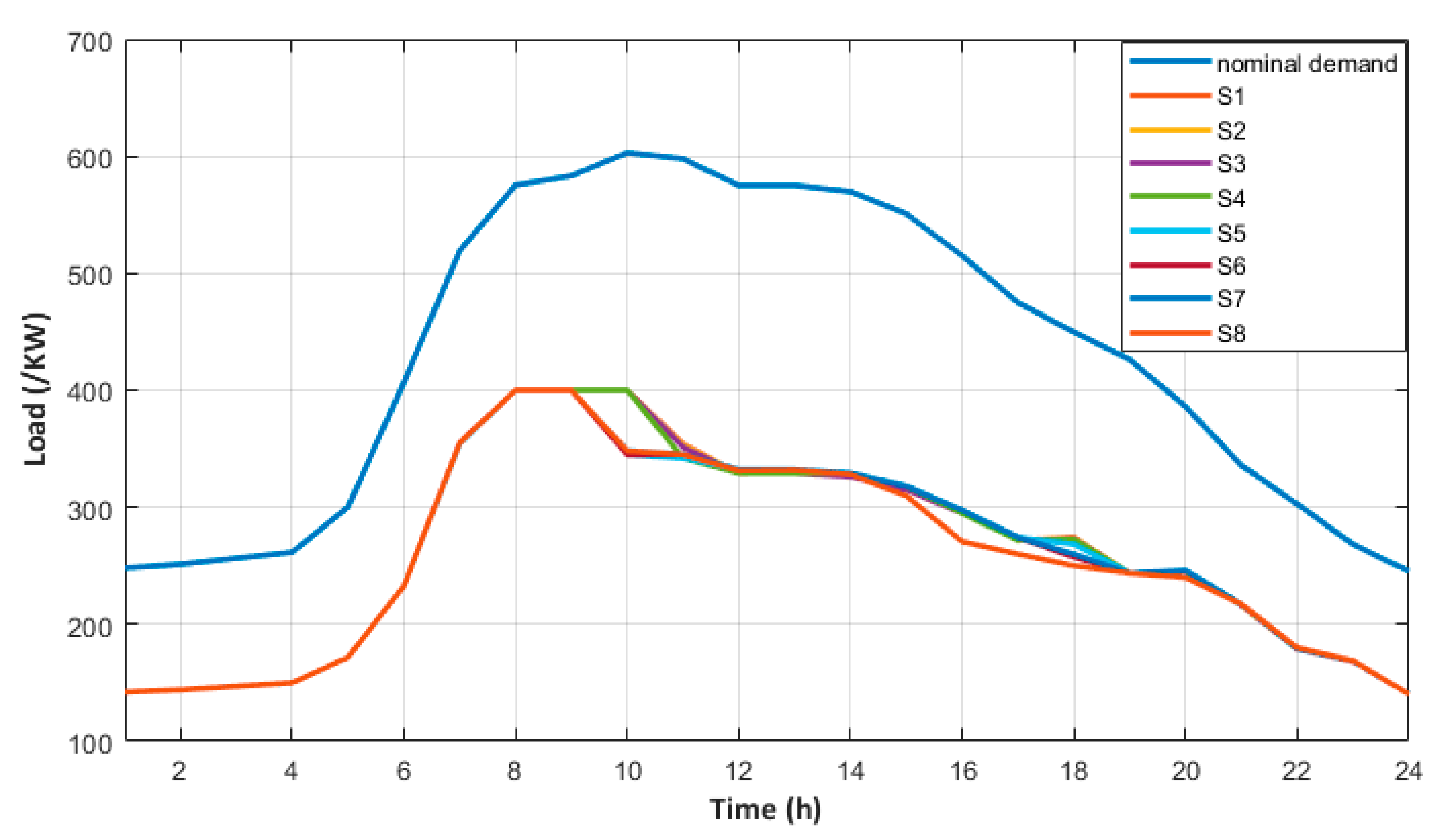
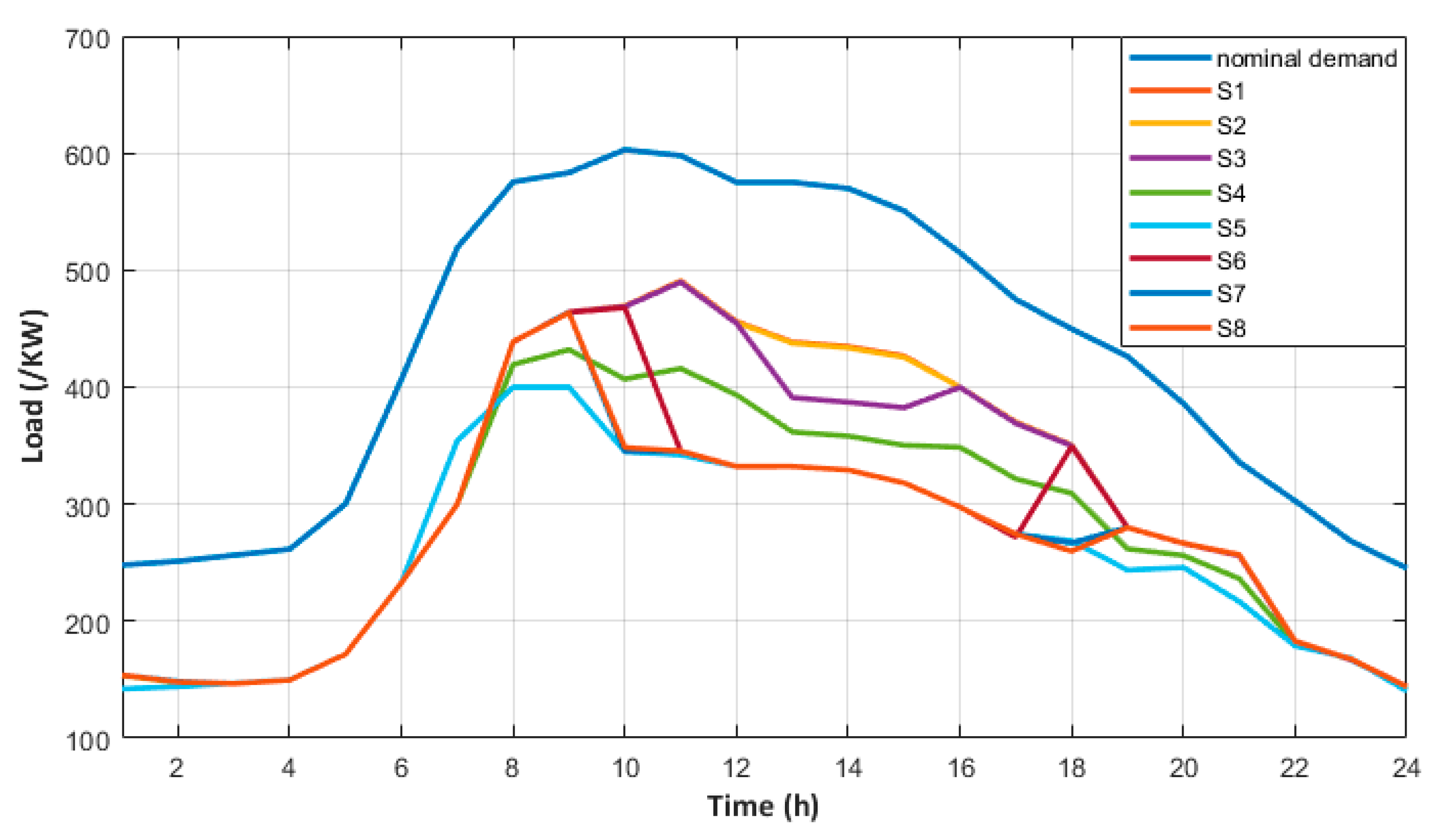
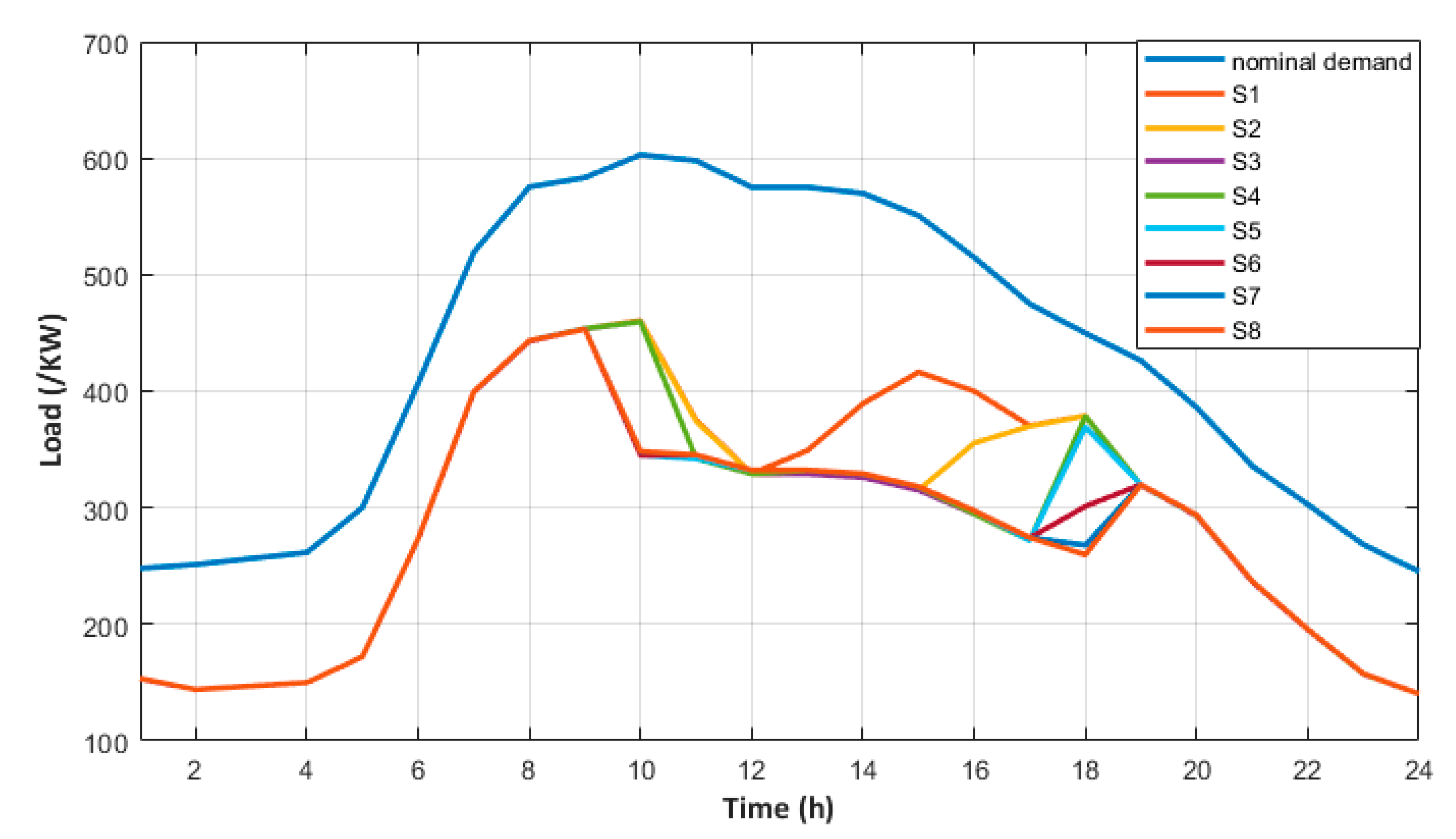

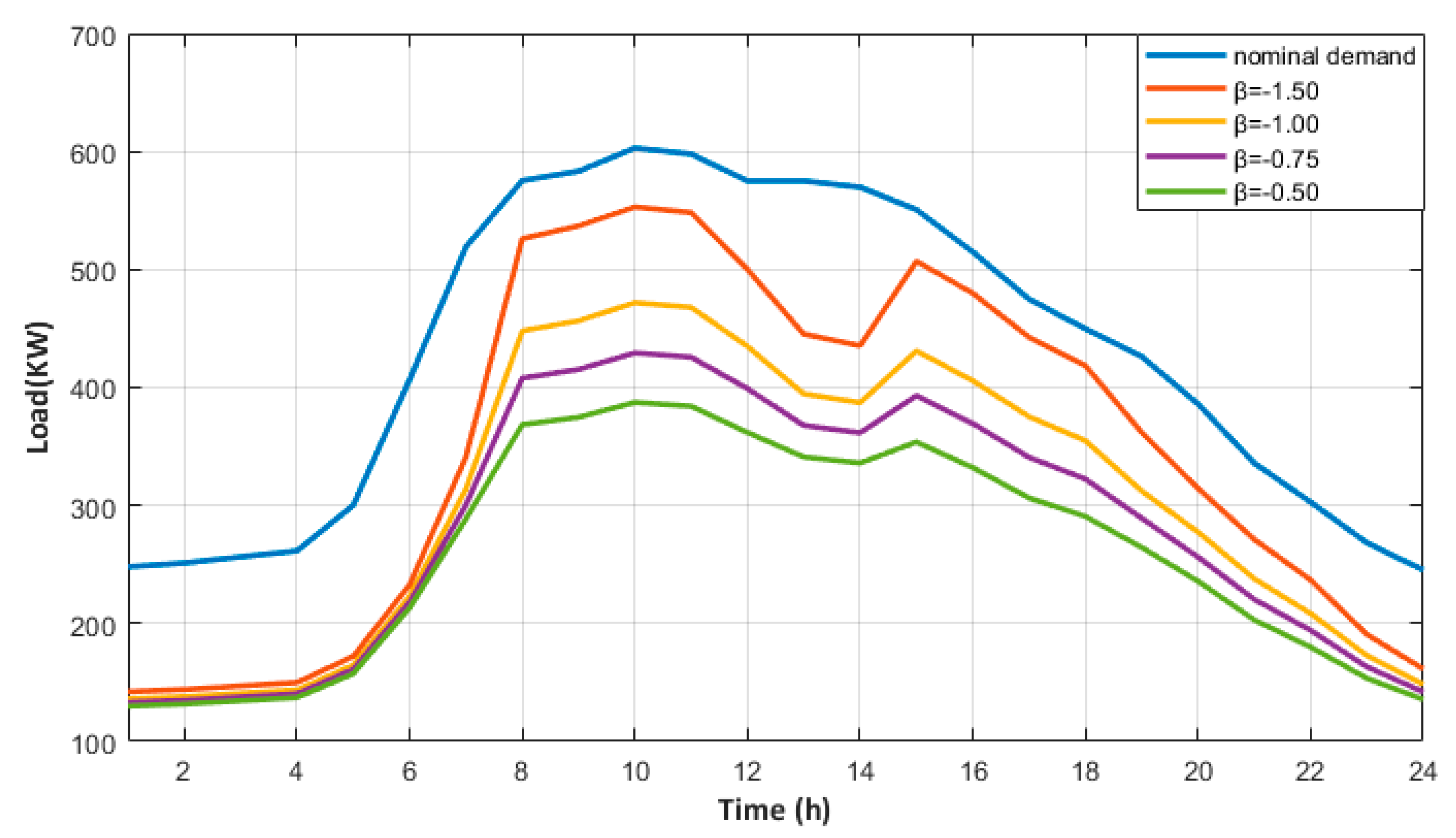
| Unit | Start-Up Cost (€/Start-Up) | Shut-Down Cost (€/Shut-Down) | CO2 Emission Factor (tnCO2/MWh) | CO2 Price (€/tnCO2) | Fuel Price (€/t for Lignite and €/MWhth for Natural Gas) | Fuel Heating Value (GJ/t for Lignite) | Efficiency (p.u.) | O&M Cost (€/MWh) | Minimum Average Variable Cost (€/MWh) |
|---|---|---|---|---|---|---|---|---|---|
| LIG-1 | 50,000 | 20,000 | 1.5 | 25 | 19.56 | 4.88 | 0.38 | 2.65 | 78.50 |
| LIG-2 | 50,000 | 20,000 | 1.4 | 25 | 7.50 | 4.29 | 0.33 | 1.50 | 55.46 |
| LIG-3 | 50,000 | 10,000 | 1.3 | 25 | 21.00 | 7.33 | 0.38 | 2.14 | 62.10 |
| LIG-4 | 50,000 | 10,000 | 1.2 | 25 | 15.77 | 4.77 | 0.33 | 1.85 | 67.43 |
| NGCC-1 | 20,000 | 10,000 | 0.37 | 25 | 15.35 | 0.00 | 0.58 | 1.20 | 37.04 |
| NGCC-2 | 20,000 | 10,000 | 0.37 | 25 | 15.35 | 0.00 | 0.57 | 1.20 | 37.58 |
| NGCC-3 | 20,000 | 10,000 | 0.37 | 25 | 15.35 | 0.00 | 0.58 | 1.20 | 37.08 |
| NGCC-4 | 20,000 | 10,000 | 0.37 | 25 | 15.35 | 0.00 | 0.60 | 1.20 | 36.03 |
| NGCC-5 | 20,000 | 10,000 | 0.37 | 25 | 15.35 | 0.00 | 0.58 | 1.20 | 36.99 |
| NGCC-6 | 20,000 | 10,000 | 0.37 | 25 | 15.35 | 0.00 | 0.51 | 1.20 | 40.76 |
| NGGT-1 | 2500 | 1000 | 0.53 | 25 | 30.00 | 0.00 | 0.40 | 1.20 | 89.45 |
| NGGT-2 | 2500 | 1000 | 0.53 | 25 | 30.00 | 0.00 | 0.40 | 1.20 | 89.45 |
| HYDRO | 0 | 0 | 0 | 25 | 0.00 | 0.00 | 0.00 | 0.00 | 3.00 |
| Unit | Technical Maximum (MW) | Technical Minimum (MW) | Technical Maximum under AGC (MW) | Technical Minimum under AGC (MW) | Primary-Up Reserve Capability (MW) | Ramp-Up Limit under AGC (MW/min) | Ramp-Down Limit under AGC (MW/min) | Tertiary Spinning Reserve Capability (MW) | Tertiary Non-Spinning Reserve Capability (MW) | Ramp-Up Limit (MW/min) | Ramp-Down Limit (MW/min) | Minimum Uptime (h) | Minimum Downtime (h) |
|---|---|---|---|---|---|---|---|---|---|---|---|---|---|
| LIG-1 | 342 | 188 | 0 | 0 | 28 | 0 | 0 | 45 | 0 | 4 | 4 | 16 | 1 |
| LIG-2 | 289 | 151 | 0 | 0 | 28 | 0 | 0 | 45 | 0 | 4 | 4 | 16 | 1 |
| LIG-3 | 256 | 195 | 0 | 0 | 28 | 0 | 0 | 45 | 0 | 4 | 4 | 16 | 1 |
| LIG-4 | 273 | 150 | 0 | 0 | 28 | 0 | 0 | 45 | 0 | 4 | 4 | 16 | 1 |
| NGCC-1 | 378 | 220 | 360 | 240 | 36 | 12 | 12 | 340 | 340 | 12 | 12 | 12 | 3 |
| NGCC-2 | 422 | 195 | 390 | 220 | 36 | 12 | 12 | 380 | 380 | 12 | 12 | 12 | 3 |
| NGCC-3 | 390 | 220 | 370 | 240 | 36 | 10.5 | 10.5 | 351 | 351 | 10.5 | 10.5 | 12 | 3 |
| NGCC-4 | 433 | 195 | 390 | 220 | 36 | 14 | 14 | 390 | 390 | 14 | 14 | 12 | 3 |
| NGCC-5 | 417 | 182 | 390 | 200 | 36 | 19.2 | 19.2 | 375 | 375 | 24 | 24 | 12 | 3 |
| NGCC-6 | 550 | 94 | 550 | 94 | 36 | 12 | 12 | 495 | 495 | 12 | 12 | 12 | 3 |
| NGGT-1 | 150 | 50 | 120 | 63 | 8 | 7 | 7 | 120 | 120 | 8 | 8 | 1 | 1 |
| NGGT-2 | 160 | 55 | 128 | 69 | 8 | 7 | 7 | 125 | 125 | 8 | 8 | 1 | 1 |
| HYDRO | 1000 | 0 | 1000 | 25 | 0 | 150 | 150 | 1000 | 1000 | 150 | 150 | 0 | 0 |
| Scenario | S1 | S2 | S3 | S4 | S5 | S6 | S7 | S8 |
|---|---|---|---|---|---|---|---|---|
| PV (MW) | 1000 | 2000 | 3000 | 4000 | 5000 | 6000 | 7000 | 8564 |
| Lignite (GWh) | 1042.02 | 975.23 | 764.25 | 521.05 | 391.56 | 302.43 | 341.85 | 1751.242 |
| Natural gas (GWh) | 13,944.41 | 14,163.34 | 13,923.14 | 13,583.90 | 13,425.54 | 13,060.16 | 13,537.81 | 12,970.15 |
| Hydro (GWh) | 1026.92 | 1026.92 | 1026.92 | 1026.92 | 1026.92 | 1026.92 | 1026.92 | 1026.92 |
| RES (GWh) | 3748.20 | 5183.42 | 6614.80 | 7981.51 | 8907.63 | 9427.45 | 9294.21 | 9029.44 |
| Imports (GWh) | 1523.43 | 983.0232 | 811.01 | 525.06 | 314.15 | 294.04 | 180.33 | 141.94 |
| Exports (GWh) | −5652.59 | −6699.54 | −7507.73 | −8006.06 | −8433.40 | −8478.60 | −8748.74 | −9287.30 |
| Demand (GWh) | 15,632.41 | 15,632.41 | 15,632.41 | 15,632.41 | 15,632.41 | 15,632.41 | 15,632.41 | 15,632.41 |
| RES curtailment (GWh) | 0 | 0 | 3.84 | 72.35 | 581.45 | 1496.85 | 3065.31 | 5576.03 |
| Unmet energy (GWh) | 0 | 0 | 0 | 0 | 0 | 0 | 0 | 0 |
| Marginal Price (€/MWh) | 49.17 | 48.40 | 46.84 | 44.02 | 40.17 | 37.64 | 35.44 | 33.14 |
| FCs | Blocks | Block Size (kW) | 01:00–14:00 h (€/MWh) | 15:00–18:00 h (€/MWh) | 19:00–22:00 h (€/MWh) | 23:00–00:00 h (€/MWh) |
|---|---|---|---|---|---|---|
| 1 | 1 | 100 | 39.13 | 37.62 | 51.62 | 42.23 |
| 1 | 2 | 100 | 43.05 | 41.38 | 56.78 | 46.45 |
| 1 | 3 | 100 | 47.35 | 45.52 | 62.46 | 51.09 |
| 1 | 4 | 100 | 52.09 | 50.07 | 68.70 | 56.20 |
| 1 | 5 | 100 | 57.30 | 55.08 | 75.57 | 61.82 |
| 2 | 1 | 80 | 39.79 | 38.25 | 52.48 | 42.94 |
| 2 | 2 | 80 | 43.77 | 42.08 | 57.73 | 47.23 |
| 2 | 3 | 80 | 48.15 | 46.29 | 63.51 | 51.95 |
| 2 | 4 | 80 | 52.96 | 50.91 | 69.86 | 57.15 |
| 2 | 5 | 80 | 58.26 | 56.01 | 76.84 | 62.86 |
| 3 | 1 | 60 | 40.46 | 38.90 | 53.37 | 43.66 |
| 3 | 2 | 60 | 44.51 | 42.78 | 58.70 | 48.02 |
| 3 | 3 | 60 | 48.96 | 47.06 | 64.57 | 52.83 |
| 3 | 4 | 60 | 53.85 | 51.77 | 71.03 | 58.11 |
| 3 | 5 | 60 | 59.24 | 56.95 | 78.13 | 63.92 |
| 4 | 1 | 40 | 41.14 | 39.55 | 54.26 | 44.39 |
| 4 | 2 | 40 | 45.25 | 43.50 | 59.69 | 48.83 |
| 4 | 3 | 40 | 49.78 | 47.85 | 65.66 | 53.71 |
| 4 | 4 | 40 | 54.76 | 52.64 | 72.23 | 59.09 |
| 4 | 5 | 40 | 60.23 | 57.90 | 79.45 | 64.99 |
| 5 | 1 | 20 | 41.83 | 40.21 | 55.18 | 45.14 |
| 5 | 2 | 20 | 46.02 | 44.23 | 60.69 | 49.65 |
| 5 | 3 | 20 | 50.62 | 48.66 | 66.76 | 54.62 |
| 5 | 4 | 20 | 55.68 | 53.52 | 73.44 | 60.08 |
| 5 | 5 | 20 | 61.25 | 58.88 | 80.78 | 66.09 |
| Scenario | Income (€) | Profit (€) | Profitability |
|---|---|---|---|
| #1 | 1193.892 | 641.919 | 0.538 |
| #2 | 1156.077 | 609.669 | 0.527 |
| #3 | 984.374 | 477.038 | 0.485 |
| #4 | 964.551 | 468.424 | 0.486 |
| #5 | 888.334 | 440.658 | 0.496 |
| #6 | 886.789 | 435.821 | 0.491 |
| #7 | 798.472 | 387.762 | 0.486 |
| #8 | 785.271 | 380.089 | 0.484 |
| Scenario | Income (€) | Profit (€) | Profitability |
|---|---|---|---|
| #1 | 614.113 | 205.150 | 0.334 |
| #2 | 612.801 | 204.399 | 0.334 |
| #3 | 608.985 | 202.605 | 0.333 |
| #4 | 570.626 | 189.922 | 0.333 |
| #5 | 497.872 | 164.563 | 0.333 |
| #6 | 477.856 | 158.067 | 0.331 |
| #7 | 446.772 | 148.919 | 0.333 |
| #8 | 403.441 | 132.427 | 0.328 |
| Scenario | Income (€) | Profit (€) | Profitability |
|---|---|---|---|
| #1 | 878.211 | 380.958 | 0.434 |
| #2 | 876.408 | 379.572 | 0.433 |
| #3 | 842.977 | 355.610 | 0.422 |
| #4 | 755.901 | 301.604 | 0.399 |
| #5 | 648.294 | 244.434 | 0.377 |
| #6 | 595.642 | 228.065 | 0.383 |
| #7 | 535.919 | 193.453 | 0.361 |
| #8 | 502.484 | 182.825 | 0.364 |
| Scenario | Income (€) | Profit (€) | Profitability |
|---|---|---|---|
| #1 | 823.845 | 346.528 | 0.421 |
| #2 | 772.802 | 312.814 | 0.405 |
| #3 | 728.675 | 284.331 | 0.390 |
| #4 | 680.723 | 270.503 | 0.397 |
| #5 | 618.500 | 241.296 | 0.390 |
| #6 | 570.156 | 219.897 | 0.386 |
| #7 | 546.718 | 210.790 | 0.386 |
| #8 | 530.865 | 325.515 | 0.387 |
| Elasticity | Income (€) | Profit (€) | Profitability |
|---|---|---|---|
| −1.50 | 1193.892 | 641.919 | 0.538 |
| −1.00 | 1192.364 | 711.843 | 0.597 |
| −0.75 | 1244.569 | 800.377 | 0.643 |
| −0.50 | 1404.487 | 996.412 | 0.709 |
| Hour (h) | FCs (%) | Pool Market (%) | Total Energy (%) | Hour (h) | FCs (%) | Pool Market (%) | Total Energy (%) |
|---|---|---|---|---|---|---|---|
| 1 | 0 (S1) 0 (S8) | 100 (S1) 100 (S8) | 100 | 13 | 100 (S1) 0 (S8) | 0 (S1) 100 (S8) | 100 |
| 2 | 0 (S1) 0 (S8) | 100 (S1) 100 (S8) | 100 | 14 | 100 (S1) 0 (S8) | 0 (S1) 100 (S8) | 100 |
| 3 | 0 (S1) 0 (S8) | 100 (S1) 100 (S8) | 100 | 15 | 100 (S1) 0 (S8) | 0 (S1) 100 (S8) | 100 |
| 4 | 0 (S1) 0 (S8) | 100 (S1) 100 (S8) | 100 | 16 | 100 (S1) 0 (S8) | 0 (S1) 100 (S8) | 100 |
| 5 | 0 (S1) 0 (S8) | 100 (S1) 100 (S8) | 100 | 17 | 0 (S1) 0 (S8) | 100 (S1) 100 (S8) | 100 |
| 6 | 0 (S1) 0 (S8) | 100 (S1) 100 (S8) | 100 | 18 | 0 (S1) 0 (S8) | 100 (S1) 100 (S8) | 100 |
| 7 | 100 (S1) 100 (S8) | 0 (S1) 0(S8) | 100 | 19 | 0 (S1) 0 (S8) | 100 (S1) 100 (S8) | 100 |
| 8 | 100 (S1) 100 (S8) | 0 (S1) 0(S8) | 100 | 20 | 0 (S1) 0 (S8) | 100 (S1) 100 (S8) | 100 |
| 9 | 100 (S1) 100 (S8) | 0 (S1) 0(S8) | 100 | 21 | 0 (S1) 0 (S8) | 100 (S1) 100 (S8) | 100 |
| 10 | 0 (S1) 0 (S8) | 100 (S1) 100 (S8) | 100 | 22 | 0 (S1) 0 (S8) | 100 (S1) 100 (S8) | 100 |
| 11 | 100 (S1) 0 (S8) | 0 (S1) 100 (S8) | 100 | 23 | 0 (S1) 0 (S8) | 100 (S1) 100 (S8) | 100 |
| 12 | 100 (S1) 0 (S8) | 0 (S1) 100 (S8) | 100 | 24 | 0 (S1) 0 (S8) | 100 (S1) 100 (S8) | 100 |
Publisher’s Note: MDPI stays neutral with regard to jurisdictional claims in published maps and institutional affiliations. |
© 2020 by the authors. Licensee MDPI, Basel, Switzerland. This article is an open access article distributed under the terms and conditions of the Creative Commons Attribution (CC BY) license (http://creativecommons.org/licenses/by/4.0/).
Share and Cite
Panapakidis, I.P.; Koltsaklis, N.; Christoforidis, G.C. A Novel Integrated Profit Maximization Model for Retailers under Varied Penetration Levels of Photovoltaic Systems. Energies 2021, 14, 92. https://doi.org/10.3390/en14010092
Panapakidis IP, Koltsaklis N, Christoforidis GC. A Novel Integrated Profit Maximization Model for Retailers under Varied Penetration Levels of Photovoltaic Systems. Energies. 2021; 14(1):92. https://doi.org/10.3390/en14010092
Chicago/Turabian StylePanapakidis, Ioannis P., Nikolaos Koltsaklis, and Georgios C. Christoforidis. 2021. "A Novel Integrated Profit Maximization Model for Retailers under Varied Penetration Levels of Photovoltaic Systems" Energies 14, no. 1: 92. https://doi.org/10.3390/en14010092
APA StylePanapakidis, I. P., Koltsaklis, N., & Christoforidis, G. C. (2021). A Novel Integrated Profit Maximization Model for Retailers under Varied Penetration Levels of Photovoltaic Systems. Energies, 14(1), 92. https://doi.org/10.3390/en14010092







